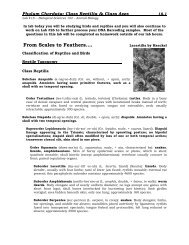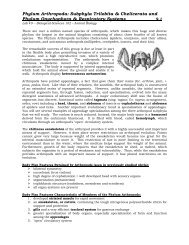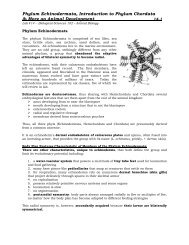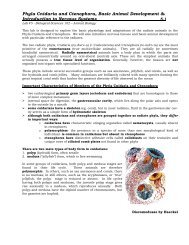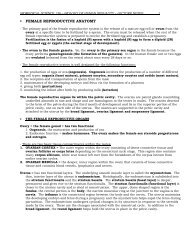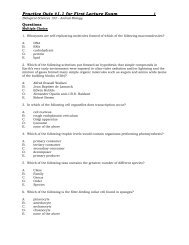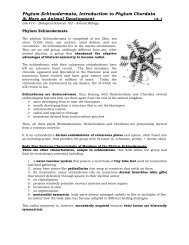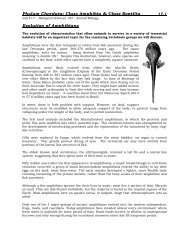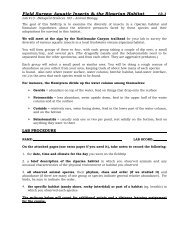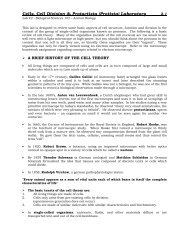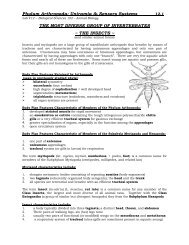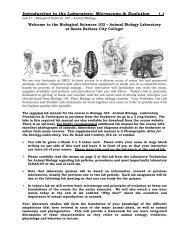Acoelomates: Phylum Platyhelminthes and Nemertea - Biosciweb.net
Acoelomates: Phylum Platyhelminthes and Nemertea - Biosciweb.net
Acoelomates: Phylum Platyhelminthes and Nemertea - Biosciweb.net
You also want an ePaper? Increase the reach of your titles
YUMPU automatically turns print PDFs into web optimized ePapers that Google loves.
<strong>Acoelomates</strong>: <strong>Phylum</strong> <strong>Platyhelminthes</strong> <strong>and</strong> <strong>Nemertea</strong> <strong>and</strong><br />
Pseudocoelomates: Phyla Nematoda <strong>and</strong> Rotifera & Parasitism 6.4<br />
Lab #6 - Biological Sciences 102 – Animal Biology<br />
Classification & Adaptations of Pseudocoelomate Animals<br />
<strong>Phylum</strong> Nematoda (roundworms)<br />
More than 25,000 species. Roundworms. Nematodes are an extensive group with worldwide<br />
distribution. They include terrestrial, freshwater, marine, <strong>and</strong> parasitic forms. They are<br />
elongated roundworms covered with a flexible, nonliving cuticle. Circular muscles are lacking<br />
in the body wall <strong>and</strong>, in Ascaris, longitudinal muscles are arranged in four groups separated by<br />
epidermal cords (some nematodes have six or eight groups of longitudinal muscles). Cilia are<br />
completely lacking. Nematodes are found free-living in almost every conceivable habitat from<br />
arid deserts to lake bottoms, rivers, polar seas. Nematodes - both parasitic <strong>and</strong> freeliving - are<br />
incredibly abundant. A h<strong>and</strong>ful of good garden soil contains thous<strong>and</strong>s of nematodes. Some<br />
50 different species of nematodes occur in humans, most of them nonpathogenic. Some<br />
nematodes are plant parasites feeding on plant sap, especially roots.<br />
Body Plan Features & Characteristics of Members of the <strong>Phylum</strong> Nematoda<br />
(some of these traits are seen in other animal phyla):<br />
1. pseudocoelomate<br />
2. bilateral symmetry<br />
3. triploblastic structure (endoderm, mesoderm <strong>and</strong> ectoderm)<br />
4. psuedocoelomate = possess a pseudocoelom<br />
5. some degree of cephalization = head with sensory organs<br />
6. some organ systems (formed of true tissues) are present<br />
7. vermiform (worm-like) body shape<br />
8. complete digestive tract with three angled (longitudinal, circular <strong>and</strong> oblique)<br />
muscular pharynx, intestine lacking muscular walls, short rectum <strong>and</strong> anus<br />
9. excretion <strong>and</strong> osmoregulation through the cuticle <strong>and</strong> by excretory canals<br />
10. lack both cilia <strong>and</strong> flame cells/bulbs<br />
11. body wall lined with cuticle which retains body shape<br />
12. longitudinal muscles only, no circular muscles in body wall; body length or<br />
diameter does not change in movement<br />
13. hydrostatic skeleton (as muscles push against parenchyma <strong>and</strong> tissue fluids)<br />
14. dioecious; sexes separate with females larger than males; one or two tubular gonads;<br />
copulatory spicules present in males<br />
<strong>Phylum</strong> Rotifera (rotifers)<br />
There are about 2000 species of rotifers. The name "rotifer" is derived from the Latin word<br />
meaning "wheel-bearer"; making reference to the crown of cilia around the mouth of the rotifer.<br />
The rapid movement of the cilia in some species makes them appear to whirl like a wheel.<br />
Rotifers can be found in many freshwater environments <strong>and</strong> in moist soil. The habitat of<br />
rotifers may include still water environments, such as lake bottoms, as well as flowing water<br />
environments, such as rivers or streams. Rotifers are also commonly found on mosses <strong>and</strong><br />
lichens growing on tree trunks <strong>and</strong> rocks, in rain gutters <strong>and</strong> puddles, in soil or leaf litter, on<br />
mushrooms growing near dead trees, in tanks of sewage treatment plants, <strong>and</strong> even on<br />
freshwater crustaceans <strong>and</strong> aquatic insect larvae. Most species of rotifers are about 200 to 500<br />
micrometers long. However a few species, such as Rotaria neptunia may be longer than a<br />
millimeter. Rotifers are thus multicellular creatures who make their living at the scale of<br />
unicellular protists. Characteristic features of rotifers include the ciliated corona ("wheel<br />
organ") <strong>and</strong> the mastax. The corona is located anteriorly <strong>and</strong> functions in locomotion <strong>and</strong> food<br />
gathering. The corona is modified extensively in some species. The mastax is a muscular<br />
pharynx containing a complex set of hard jaws or trophi <strong>and</strong> is found in all rotifers. These<br />
characteristics of these structures have been used extensively in classifying rotifers.



